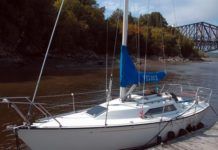Morgan 24/25
Back in 1965, a St. Petersburg, Florida sailmaker named Charlie Morgan, who had been dabbling with custom racing yacht design and had come up with a remarkable string of winners, started producing a series of small- to medium-sized production boats. Introduced late that year, the Morgan 24 joined the Morgan 30, 34 and 38, becoming an instant success as a fast cruiser and club racer.
Tripp 26
This 26-footer is totally unlike familiar racer/cruisers from Pearson, Catalina or Hunter. For openers, it looks like a hot rod. The fine entry of its plumb bow and reverse transom give it a grand prix look, as does its 8' 8" beam. The boat displaces only 2,900 pounds on a 22' 0" waterline. It has a 7/8 rig supported by a pair of swept-back spreaders. Standing rigging is 3/16" wire on the uppers, forestay and lowers, 5/32" on the intermediates and running backstays. Ease of movement along wide decks is assisted by inboard shrouds.
C&C 27 Boat Review
This fast and handsome cruiser/racer from the 1970s is an excellent example of what made C&C Yachts such a successful company. C&C stands for George Cuthbertson & George Cassian, the design team that, in 1969, joined in partnership with Belleville Marine Yard, Hinterhoeller Ltd. and Bruckmann Manufacturing to form C&C Yachts. The company had a tumultuous history, from growing to capture an estimated 20 percent of the U.S. market during the 1970s, to suffering a devastating fire in 1994 while owned by Hong Kong businessmen Anthony Koo and Frank Chow of Wa Kwang Shipping. Along the way, they built a tremendous number of boats, not only in the racer/cruiser genre that was their mtier, but also the Landfall cruiser line, and a few oddballs such as the 1977 Mega 30 with a retractable fin keel; the Mega 30 and a handful of others simply bombed.
The Evolution of the C&C 27 Cruiser-Racer
C&C Yachts produced four versions-and nearly 1,000 hulls-of its popular C&C 27 boat. Called the C&C 27 Mark I, Mark II, Mark III, and Mark IV, these boats differed in various ways, but the hulls were similar. A fifth design, the C&C 27 Mark V, was a totally different design. Heres a look at the various editions of the C&C 27, and how they differed from one another.
Bristol Channel Cutter, Morris 40, Alerion Sloop
The Alerion Sloop, Bristol Channel Cutter and Morris 40 cover the range from gentleman's daysailer to blue-water passagemaker. Each is of superior design and construction-it's nice to know you can still buy quality, but you'd better have deep pockets.
Four Trailer-Sailers And the Keel/Launch Problem
Looking back at the Paceship PY 23, American 26, Yankee Dolphin24, and Aquarius 23-we can examine several other approaches to the same problem. That is for stability, a sailboat must have an underwater appendage such as a keel or centerboard, and ballast. Both are at odds with the concept of an easily trailerable boat that can be launched at most ramps. A deep fixed keel is untenable.
Baba 30
The Baba line of boats was conceived in the mid-1970's by Bob Berg, a Seattle yacht broker who with two business associates formed Flying Dutchman International Ltd. to import traditionally styled cruising boats from Taiwan. Bob Perry was commissioned to design the boats, which Berg envisioned as a smaller version of the Tayana 37, one of Perry's most popular designs. Though it is a full-keeled boat, the Tayana 37 has a greater turn of speed than…
The J/80
Comparing the J/80 with the Melges 24 may provide a frame of reference because of their similarities and differences. The Melges is clearly a faster boat, rating in the 90s, despite being nearly 2 shorter.Both have cavernous cockpits designed and rigged to maximize performance. Though waterline length, draft, and beam measurements are close, there are major differences. The Melges has a retractable keel and performs like an overgrown dinghy; the J/80 has a fixed keel. It is less buoyant and more comfortable going to weather in a chop.
A Herreshoff Legacy Lives On
It took some time for the Stuart Knockabout, an L. Francis Herreshoff design, to take root and finally flourish. The 28-foot day boat first appeared in 1932 as line drawing number 53 in the L. Francis annals, and only one boat was built. In 1933, Ben My Chree (a Galic term of endearment), was launched and wound up nestled away in Casco Bay, Maine, at the island home of owner Willoughby Stuart. With its own small marine railway and boat shed, Ben My Chree remained in the family for nearly 40 years. In the mid-1980s, it was discovered in a Massachusetts boat shed by Bill Harding, a sailor known for his deft hand on the tiller and the builder of the popular Herreshoff 12 replica-affectionately known as the Doughdish. Harding fell for the lines of daysailer he had discovered, and he researched the boats lineage. After getting a feel for what it had to offer under sail, he decided that this was another slice of sailing history that deserved being resurrected.
Craftsmanship is at the Heart of Construction
Modern engineering works well with many older designs. In the Stuart Knockabouts original plans, soft wood planks were mechanically fastened to hardwood frames and the its shoal-draft keel/centerboard was bolted to the keelson. Timber boatbuilding is labor intensive and the time-saving shortcuts found in molded FRP hull and deck construction have a well-proven track record. Add to this the fact that wooden hulls and decks are susceptible to rot, and its clear that Hardings vision of a fiberglass/foam sandwich Stuart Knockabout was a best-of-both-worlds solution rather than a sacrilege. The result of the FRP conversion is a stiffer/stronger, monocoque hull that required less maintenance and is much more immune to the elements.













































